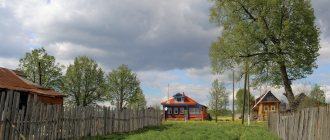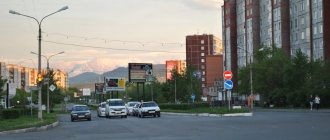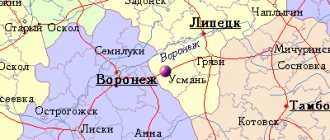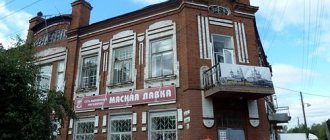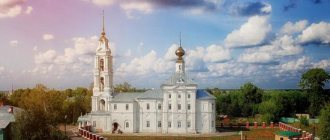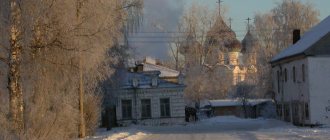What to see
The city is a living monument to the enthusiastic builders who laid the railway.
Most of the city's attractions are, in one way or another, connected with BAM. On the highway between Severobaikalsk and Nizhneangarsk, there is a memorial dedicated to the pioneers - the landing of the tunnelers. The First Tent monument is considered the site of the founding of the city. Nearby, from the observation deck, there is a magnificent view of Lake Baikal and the cape tunnels.
Cape tunnels, cut through the spurs of the Baikal ridge, are an exceptional attraction. These structures are rightly called “the keys to the BAM”. The final choice of the location of the entire highway depended on their successful installation.
The monument is dedicated to the tunnel detachment TO-16 and was erected on the day of the construction of the 3rd tunnel. There are 4 of them in total, with a total length of more than 5 km. All of the detachment’s tunnelers were metro builders, so the letter “M” on the memorial is entirely justified. The heavy equipment that helped people in their work has not been forgotten either.
Yellow MoAZ, a 25-ton underground road train, is installed on a concrete pedestal near the portal of the 2nd tunnel. This machine worked at Mysovye from 1975 to 1982.
In the city itself it will be interesting to visit an art gallery. It opened in 1979, when artists of the USSR donated 500 of their paintings to the new building. Now the museum has more than 2,000 paintings in its collection.
The Museum and Exhibition Complex is located in the same building. The museum is quite small, but extremely atmospheric; the exhibition gives a complete picture of the 40-year history of the construction of BAM. There is an exhibition telling about the life of the Evenks and Buryats, and there are exhibits that give an idea of the nature of the region.
Nearby is the Zheleznodorozhnik Palace of Culture with a huge winter garden - about 100 species of exotic plants. Premiere film screenings, concerts and festivals regularly take place here.
In 2009, the Temple of the Kazan Icon of the Mother of God opened. The church was built at the expense of parishioners.
Onokachanskaya Bay is the visiting card of Northern Baikal. Here is Obo, a place of worship for the Buryats and the first illuminated Suburgan (Stupa) according to Buddhist traditions. The place is considered energetically strong, bringing peace of mind and reconciliation.
Why go to Severobaykalsk?
See the capital of BAM, enjoy the blooming wild rosemary, catch grayling and whitefish on the lake, go on a cave quest, plunge into hot springs, look at seals, try omul, go rafting and freeride.
You can pitch a tent and enjoy maximum freedom at a minimum cost on Yarki Island, or book a room in the posh “Baikal Residence”, where guests are delivered by boat or helicopter. Or you can choose something in between - order a ready-made tour with transfer, bathhouse, excursions and overnight stay in a tent.
Severobaykalsk is the starting point of many tourist routes. Here you can find interesting activities for every taste.
Thermal springs
There are several of them near the city - Dzelinda, Goudzhekit (Solnechny), Kotelnikovsky and Khakusy. These are nitrogen thermal baths, carbonated with nitrogen, methane and hydrogen sulfide. Some of the springs are hyperthermal. The high temperature remains even in the most severe frosts.
The hot spring at Cape Kotelnikovsky is difficult to access and is visited by hiking or horseback tourist groups. This is one of the popular routes leading to the highest point of the Baikal ridge - the city of Charsky.
There is no road. In summer you can get there by water, in winter along the ice of Lake Baikal. A recreation center has been built here, and the indoor swimming pool is open all year round.
In Khakusy Bay there is a balneological resort of the same name. The landscape and microclimate here are exceptionally beautiful. Lots of pines, cedar, juniper, fir. The water of Khakusy is similar in composition to the springs of Pyatigorsk.
Dzelinda is located 92 km from Severobaikalsk in the Upper Angara valley. Water temperature +44○C. The presence of radon gives the spring a special healing effect, and the low content of hydrogen sulfide has a beneficial effect on the general atmosphere.
The Solnechny Spring (Goudzhekit) is an outlet of pressurized thermal waters. The well is very close to the city, 3 km to the west. There is a complex with an outdoor swimming pool.
Before visiting the springs, consult your doctor. Despite the undoubted benefits of thermal baths, there are many medical contraindications.
There are small cottage-type hotels near the springs. During the season, most hiking routes start from here.
Weather in Severobaykalsk
What is the weather in Severobaikalsk right now and the forecast for the next week
In winter, the average air temperature in Severobaikalsk reaches up to – 25 C°, but there can be severe frosts down to – 43 C°, but they usually fall at the beginning of January, as elsewhere on Lake Baikal.
In summer, the average air temperature in Severobaikalsk can reach up to +25 C°
, in July and August sometimes the thermometer rises above
+30 C°.
The warmest place, which is very loved by tourists and local residents, is Yarki Island, where the water can warm up to +25 degrees.
Severobaikalsk is a very sunny place, like Lake Baikal in general; in terms of the number of sunny days it can compete with any southern resort, not only in summer, but all year round.
Ski resorts Ursa Major and Ursa Minor
They are located 30 km from Severobaikalsk on the Davan Pass. Trails of varying difficulty levels. The slope is equipped with a lift. The elevation difference is 200 m. There is equipment rental and the possibility of freeride.
The bases accept guests from February to April. Skiing can be combined with relaxation in the thermal baths.
Climate[edit]
Severobaykalsk, as a Siberian city, has a subarctic climate, characterized by sharp temperature fluctuations between seasons. It can be very warm in summer and very cold in winter. The warmest month of the year in Severobaykalsk is July, when the average temperature is +16 °C (61 °F). The coldest month of the year is January, when the average temperature is -23 °C (-9 °F).
| Climate data for Severobaykalsk | |||||||||||||
| Month | Jan | Feb | Mar | Apr | May | Jun | Jul | Aug | Sep | October | But I | December | Year |
| Average high °C (°F) | -17,3 (0,9) | -14,7 (5,5) | -4,8 (23,4) | 3,6 (38,5) | 12,0 (53,6) | 19,5 (67,1) | 22,4 (72,3) | 20,9 (69,6) | 13,7 (56,7) | 3,8 (38,8) | -6,3 (20,7) | -12,9 (8,8) | 3,3 (38,0) |
| Daily average °C (°F) | -22,9 (-9,2) | -21,6 (-6,9) | -12,9 (8,8) | -2,9 (26,8) | 5,0 (41,0) | 11,9 (53,4) | 15,7 (60,3) | 14,7 (58,5) | 7,9 (46,2) | -1,0 (30,2) | -11,5 (11,3) | -18,2 (-0,8) | -3,0 (26,6) |
| Average low °C (°F) | -28,4 (-19,1) | -28,5 ( -19,3 ) | -21,0 (-5,8) | -9,4 (15,1) | -1,9 (28,6) | 4,4 (39,9) | 9,1 (48,4) | 8,6 (47,5) | 2,2 (36,0) | -5,8 (21,6) | -16,7 (1,9) | -23,4 (-10,1) | -9,2 (15,4) |
| Average precipitation, mm (inches) | 16 (0,6) | 12 (0,5) | 10 (0,4) | 17 (0,7) | 28 (1,1) | 37 (1,5) | 65 (2,6) | 63 (2,5) | 42 (1,7) | 23 (0,9) | 22 (0,9) | 19 (0,7) | 354 (14,1) |
| Source: Climate-Data.org [12] | |||||||||||||
Slyudyanskie lakes and Cape Ludar
Located 25 km from the city. The two lakes Big and Small are separated by a narrow strip of land. There are wonderful pebble beaches here. The depth of the lakes is shallow, they warm up well.
There is a hiking route along the serpentine path to the mica adits. The ascent takes about 2 hours. In the 1930s, prisoners of the Boguchansky Gulag mined mica here for the radio industry. At the end of the path, a panoramic view of Lake Baikal and Tonky Cape opens up.
Cape Ludar is one of the most beautiful places on Lake Baikal and a monument to Kurykan culture. At the top of the rocky ledge are the remains of an ancient settlement and a cave with petroglyphs. The site of primitive people in the Great Ludar Cave existed more than 4,000 years ago.
Fans of ancient history will be interested in visiting the village of Baikalskoye, on its territory there are several Neolithic sites. The village has a developed infrastructure and there is a place to stay.
General information
Located on the northern shore of Lake Baikal, 440 km from Ulan-Ude and 500 km from Irkutsk (in a straight line), on the left bank of the mouth of the Tyya River, on the Baikal-Amur Mainline, 24 km southwest of the center of the Severobaikalsky region - the village of Nizhneangarsk . The city has a large station Severobaikalsk of the East Siberian Railway.
Population: 23,944 people (2016).
The city owes its existence to the construction of the Baikal-Amur Mainline.
There are no large industrial enterprises in the city; the main enterprise is the railway department. The city has an art gallery and a BAM museum.
Severobaikalsky district
The Severobaikalsky district is located on the coast of the northern part of the island. Baikal. Area - 53,990 km2. The Baikal-Amur Mainline passes through its territory.
There are 12 settlements in the region.
90% of the territory is pristine, ecologically clean places where tourist centers, hot springs, and hydropathic clinics are located.
There are seven secondary schools and five additional education institutions in Severobaikalsk: a children's and youth sports school, a school of tourism and environmental education, a children's creativity center "Eureka", a traditional culture center "Bayar" and vocational lyceum No. 19. Branches of the Irkutsk State Transport University are opened here , Moscow State University of Service, Siberian College of Construction and Entrepreneurship, Ulan-Ude Engineering and Pedagogical College.
During the years of perestroika, a network of cultural institutions has been preserved in Severobaikalsk: the Baikal and Sovremennik cultural centers, the Zheleznodorozhnik palace of culture and technology, three libraries, an art gallery, the BAM history museum, the School of Arts, a television studio, a park of culture and recreation, a folk ensemble song and dance "Geser", vocal and instrumental ensemble "Pulsar", dance ensemble "Visit". The population of the city is served by a departmental hospital of the Eastern Railway and a clinic equipped with modern diagnostic equipment.
Severobaykalsk is a center of tourism and sports. For sports lovers, the White Sail yacht club, the Neva sports complex, the Stroitel stadium, the Parus swimming pool, as well as the Big Dipper ski slope, open in accordance with the city sports development program, are available.
Source: Baikal: nature and people: encyclopedic reference book / Baikal Institute of Nature Management SB RAS - Ulan-Ude: ECOS: Publishing House BSC SB RAS, 2009.
Frolikha Nature Reserve and Lake Frolikha
Lake Frolikha arose as a result of the melting of the last glacier on the planet. The average depth of the reservoir is 80 m. Since its formation, the ecosystem has remained virtually unchanged. This is virgin territory where perception works completely differently. The water here is very clean and completely transparent.
The Frolikha reserve was created to preserve relict flora and fauna. To travel here it is better to take a guide. Hiking with children is not recommended. Mountain taiga is “fun” for adults. There are many wild animals here, including predators.
There are anomalous zones and territories with unusual landscapes, for example, dunes in the northern part of the reserve. The cape and Ayaya Bay are interesting. A secluded place, sheltered from the winds. Here you can see the famous Baikal seals, go fishing or hunt.
Links[edit]
Notes[edit]
- ^ abc Terentyev Yuri. "Northern Baikal region - Information about the city of Severobaikalsk". Archived from the original on September 26, 2006. Retrieved January 4, 2013.
- ^ a b Federal State Statistics Service (2011). “All-Russian Population Census 2010. Volume 1" [All-Russian Population Census 2010, vol. 1]. All-Russian Population Census 2010 [All-Russian Population Census 2010]
. Federal State Statistics Service. - "26. The size of the permanent population of the Russian Federation by municipalities as of January 1, 2022". Federal State Statistics Service. Retrieved January 23, 2022.
- ^ abc Resolution No. 431
- ^ abc Law No. 985-III
- "On the Calculation of Time". Official Internet portal of legal information
. June 3, 2011. Retrieved January 19, 2022. - Post office. Information and computing center of OASU RPO. ( Post office
).
Search for postal service objects ( postal Search for objects
) (in Russian) - ↑
Federal State Statistics Service of Russia (May 21, 2004).
“The population of Russia, the constituent entities of the Russian Federation as part of federal districts, urban settlements, settlements, settlements of 3 thousand or more people” [Population of Russia, its federal districts, federal districts, districts, urban settlements, rural settlements - administrative centers and rural settlements with a population of more than 3,000 people] (XLS). All-Russian Population Census of 2002 [All-Russian Population Census of 2002]
. - “All-Union Population Census of 1989. The current population of union and autonomous republics, autonomous regions and districts, territories, negative phenomena, urban settlements and rural district centers” [All-Union Population Census of 1989: current population of union and autonomous republics, Autonomous regions and districts , territories, regions, districts, towns and villages performing the functions of district administrative centers. All-Union Population Census of 1989 [All-Union Population Census of 1989]
.
Institute of Demography of the National Research University: Higher School of Economics [Institute of Demography of the National Research University: Higher School of Economics]. 1989 - via Demoscope Weekly
. - ^ abc Merkel, Broder (November 2004). "Severobaykalsk - a new city". Retrieved March 16, 2008.
- Stewart, John Massey (1991). Lake Baikal: on the brink? . World Conservation Union. paragraph 20. ISBN 2-8317-0037-X.
- "Severobaykalsk, Russia". Retrieved January 23, 2013.
Yarki Island
The best place for a “wild” beach holiday. 20 km of pure golden sand between Baikal and Angarsky Sor Bay. The width of the beach is about 100 m. Sand dunes alternate with pine trees and dwarf cedar. In summer, the water here is the warmest on Lake Baikal.
The best time for a holiday in Yarka is from July to September. There are wonderful sunrises, unique sunsets, excellent fishing.
For those who prefer active recreation on the water there are many routes. Rafting on the mountain river Tyya. Traveling along rivers and lakes by boat, catamaran, kayak, yacht. Fishing and hunting all year round. There is upland and waterfowl, you can catch omul and grayling.
In the summer you can take an exciting trip on the Comet: to the village of Nizhneangarsk, to the Transbaikal and Barguzinsky Nature Reserves, Chivyrkuisky Bay and Olkhon Island. If desired, in 12 hours you can cross the entire Baikal from north to south along the coastline and go ashore in Irkutsk.
The city has a large selection of hotels, cafes, restaurants and buffets. For every taste and budget. To the question “What time is best to arrive?” it is impossible to give a definite answer. After all, Severobaikalsk is, first of all, unique nature, and, as you know, it never has a bad time.
Literature
- Yuri Kozlov Road and destinies // “Ogonyok”: magazine No. 52 - 1979 p. 12-13
- Pospelov E.M.
Geographical names of the world: Toponymic dictionary: About 5000 units. M.: Russian dictionaries, Astrel Publishing House LLC, AST Publishing House LLC, 2001. p. 376 - Ch.
ed. Gorkin A.P. Geography of Russia: encyclopedic dictionary. M.: Great Russian Encyclopedia, 1998. p. 529 - Ch.
ed. Lappo G.M. Cities of Russia: encyclopedia. M.: Great Russian Encyclopedia, 1994. p. 415
Train Station
It is impossible not to mention another iconic architectural landmark of Severobaikalsk. This is the building of the city railway station, located on the Avenue of the 60th Anniversary of the USSR. It is made of concrete, metal and glass and is distinguished by an original architectural design in the form of a wave. By the way, the stylized silhouette of this building adorns the city coat of arms of Severobaikalsk.
mass media
Radio
- 66.29 MHz - Radio Russia / State Television and Radio Broadcasting Company Buryatia (Silent);
- 100.9 MHz - Radio Chanson;
- 101.5 MHz - Russian Radio;
- 102.0 MHz - Hit FM;
- 102.5 MHz - Humor FM;
- 102.9 MHz - Traffic radio;
- 103.3 MHz - Baikal Waves;
- 103.7 MHz - Radio Russia / State Television and Radio Broadcasting Company Buryatia;
- 104.1 MHz - Barguzin FM (PLAN).
A television
- TV channel "Vector Plus"
- TV channel "Arig Us"
Printed publications
- Newspaper "Northern Baikal"
Attractions
Kazan Cathedral
The Kazan Cathedral (until 2016 - the Kazan Church) is an Orthodox church, consecrated in honor of the Kazan Icon of the Mother of God, belongs to the North Baikal Diocese of the Buryat Metropolis of the Russian Orthodox Church.
In 1994, the Mother of God-Kazan parish of the Russian Orthodox Church was registered in the city. In 1995, believers were provided with premises for worship. In 2009, a church was rebuilt and consecrated in honor of the Kazan Icon of the Mother of God. On May 5, 2015, with the formation of the Buryat Metropolis, an independent Northern Baikal diocese was separated from the Ulan-Ude diocese. The Kazan Church of the city of Severobaikalsk became the cathedral of the new diocese.

